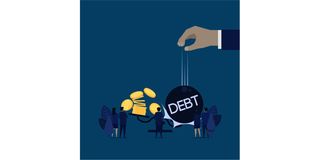‘Debt’ is not a dirty word as we often see it

Kenya's debt crisis has been cooking since the Jubilee administration took charge.
What you need to know:
- There is a legitimate question as to whether the government has been borrowing to deliver such change and transformation.
National Treasury officials must have sighed with relief following the debt repayment holiday by bilateral donors. But the suspension so far — part of the G20’s Debt Service Suspension Initiative (DSSI) — is for six months. In four months, headlines like “Kenya could fail to repay its debt in 2025”, “Kenya is in financial distress, government admits”, “Kenya likely to breach $80 billion debt ceiling by 2022” will resurface.
But is the “problem” real? Is Kenya in a debt crisis? Are media objective? No. And it isn’t about domestic politics. The problem is bigger. The headlines are based on a constrained narrative shaped outside Africa. Dating to the late 1970s, it originated from colonialism. And it needs changing.
All countries, rich and poor, borrow — from one another, taxpayer and local and international banks. Kenya really needs finance: 25 per cent of Kenyans have no electricity, 41 per cent no access to safe drinking water and 13 per cent no internet.
Private banks
Debt, particularly from other countries, international organisations or multinational private banks, can be useful in delivering these needs — especially since 40 per cent of Kenyans don’t have formal, stable jobs and, hene, can’t pay taxes or save. There is only one answer to this: To pay for structural change, for structural transformation of the economy to create jobs.
There is a legitimate question as to whether the government has been borrowing to deliver such change and transformation. For example, have loans been spent on recurrent expenditure such as salaries or on productive investments like energy, industrial parks, rail and roads? The latter can — just by their very existence — stimulate economic growth much larger than the initial investment.
The fact is, we need to get over the idea that debt is always bad. The last time Africans allowed the “dirty debt” narrative to prevail, the consequences were extremely harmful.
In the late ’70s, a so-called African debt crisis began to take shape for reasons entirely outside the continent. Kenya was never one of the African countries for whom much debt was cancelled because the economy was fairly diversified, so it was able to bounce back fairly quickly.
Basic needs
In fact, data suggests that only China cancelled any of Kenya’s debt in 2000-2018 — some $13 million. Nevertheless, public debt rose enough for multilateral organisations to propose “Structural Adjustment Programs” (SAPs), which, sadly, hindered rather than helped citizen’s abilities to access basic needs as they cut growth and government budgets.
There is a risk of a new and severe austerity trap if we acquiesce to the “debt crisis” narrative.
Externally imposed, poorly evidenced constraints have put the brakes on Kenya’s response to Covid-19, leading to initial offers of joining the DSSI.
Covid-19 is a shared global enemy. All people should share the burden equally, and that means avoiding letting Kenya’s debt become a dirty word.
[email protected]. @hmryder





